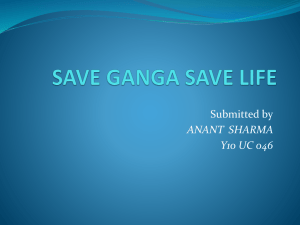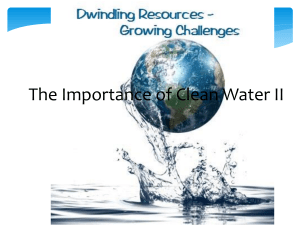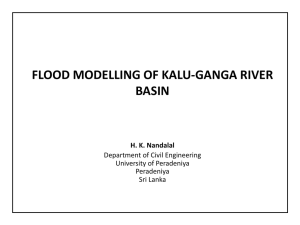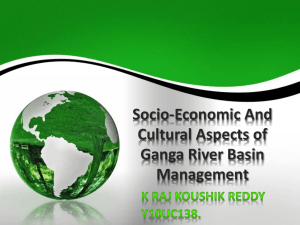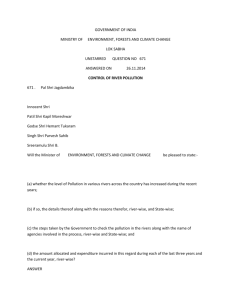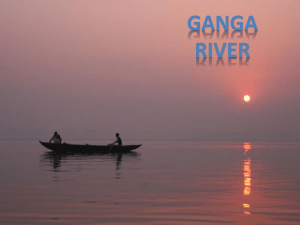Evs Presentation
advertisement
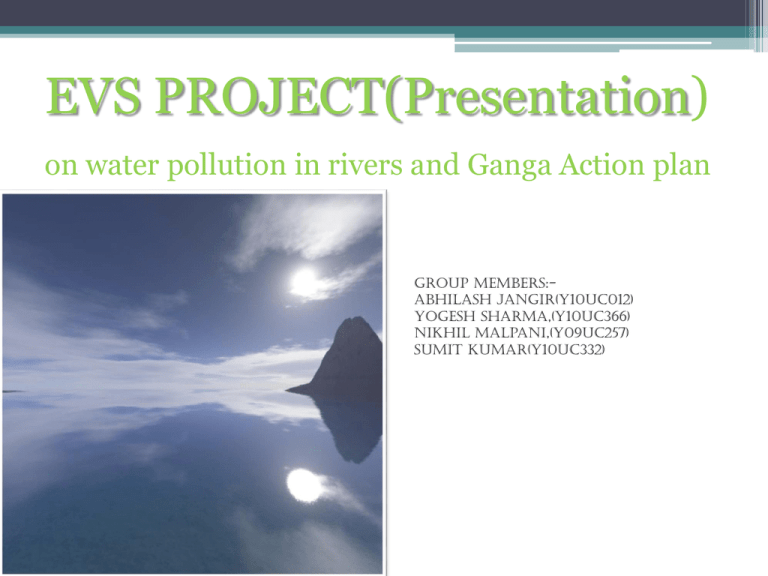
EVS PROJECT(Presentation) on water pollution in rivers and Ganga Action plan Group Members:Abhilash Jangir(y10uc012) Yogesh Sharma,(y10uc366) Nikhil Malpani,(y09uc257) Sumit kumar(y10uc332) OUTLINES • Why rivers are getting polluted? • Types of water pollution in rivers….. • Effects in future if India’s main rivers get polluted….. • What can we do ….. • Poem baseed on river Ganga…. • Conclusion………..and action plan for River ganga…. Why rivers are getting • People's negligence towards the water polluted? preservation and cleanliness. • The industrial growth and increase in population are the main causes behind the degradation of water quality across the world. • The toxic elements discarded by Industries and city sewage lead to degradation in the quality of water of rivers. • Dumping waste oil products into the river or sea can lead to water pollution. Cont… • Industrial waste products disposed to a river and sea may contaminate the water. • The contamination in the environment around the Earth's surface can lead to Atmospheric Deposition. We have already seen Acid Rains in some parts of the world. • Sewage and Waste Water:The sewage is many big cities carry all the household wastes and Industrial wastes with it and dumps that into a river. Apart from these there are many human activities that cause water pollution Types of water pollution in rivers….. • 1. Point Source Pollution:If one can identify the exact source that causes the water pollution then we call it as Point Source Water pollution. As for example, pollution caused by the sewage of city can be considered as Point Source Pollution. • 2. Non-Point Source Pollution :As the name suggests Non-Point Source Pollution is the exact opposite of Point Source Pollution. Here single source cannot be identified as the cause of water pollution. There may be many known and unknown sources that are causing the water pollution. But, one ca not pin point what all sources are responsible for the degradation of quality of water. Cont…. 3. Surface Water Pollution:The contamination of surface water due to sewage, industrial wastes is called as Surface Water Pollution. The sources of surface water are rivers, lakes, seas, oceans etc. The sources of water that exists on the surface of the Earth called as Surface Water sources. If these sources are get polluted then such type of pollution is called as Surface Water Pollution. Cont….. 4. Ground Water Pollution:As the name suggests ground water is the water that is in the heart of the Earth. They lay hundreds of feet below the surface of the Earth. The water of rain is absolved by the soil and lay beneath the ground. Ground water is used as drinking water in most of the parts of the world. If the ground water gets polluted then such pollution is known as Ground Water Pollution Effects in future if India’s main rivers get polluted….. • Damage to the cultivation of Crops. • Unavailability of pure water for drinking and other purposes • Danger to the marine life • Health related problems Cont….. - Acid rain - Produced crops can be polluted as well - Damage to the forests and trees - Affect the animals that drink water in a river or lake - Polluted water can cause diseases like cancer or heart complications. What can we do ….. • Educating people about the importance of rivers • Introducing Strict Laws to punish the people who pollute river water. • Investing in the Cleaning of Polluted Water • Charging people who pollute water Cont…. Cont…. • Fertilize garden and yard plants with manure or compost instead of commercial inorganic fertilizer. • Minimize our use of pesticides. • Do not apply fertilizer or pesticides near a body of water. • Grow or buy organic foods. • Do not drink bottled water unless tests show that your tap water is contaminated. Merely refill and reuse plastic bottles with tap water. Cont… Cont…. • All states should work together • The sewage water should be cleaned before disposing into the river. Cont… • Compost our food wastes. • Do not use water fresheners in toilets. • Do not flush unwanted medicines down the toilet. • Do not pour pesticides, paints, solvents, oil, antifreeze, or other products containing harmful chemicals down the drain or into the river. Cont… Voice Of GANGA Poem Mai Ganga nikal Himalay se, Dharti ki goad me bah rhi, Dharti ko khushal mai kar rhi, Na koi mera swarth… Na koi meri ichchha.. Phir bhi mai bah rh. Mai ganga nikal himalay se bah rhi………………. Dekhi hai maine sabhytayein Bante bigdate .. Apne me dabaye baithi hun na Jane raj kitne. Jod rhi hun ateet ko vartman se.. Dharm ko dharm se… Insaan ko insaan se, Lekin na jane kyun aaj insaan Cont…. Apne swarth me mujhko bhool gya hai. Mujhe mata ka darja dekar kyun bhool gya hai. Kya mera ant hi mera bhavishay hai Mai ganga aaj poochh rahi hun tumse…….. By-YOGESH SHARMA Conclusion and Ganga action plan • Rivers are the most precious Gift that the nature has given to the mankind. No life can be imaged if there would be no water(river). It is the sole duty of each and every person the prevent this indispensable resource from getting polluted. If we don't take this seriously, the existence of Human Beings will become a History on this Earth. Ganga Action plan • Ganga is not an ordinary river. It is a life-line, a symbol of purity and virtue for countless people of India. Ganga is a representative of all other rivers in India. Millions of Ganga devotees and lovers still throng to the river just to have a holy dip. We Indians are raised to consider Ganga as a goddess, as sacred. Map of India Showing River Ganga Ganga is a perennial river which originates as a stream called “Bhagirathi” from Gaumukh in the Gangotri glacier at 30 ° 55' N, 79 ° 7' E, some 4100 m above mean sea level. Ganga river basin is the largest among river basins in India and the fourth largest in the world. Ganga Today • The Ganga today is more polluted than when the Ganga Action Plan was first initiated. • The fast shrinking glaciers, dams, barrages, canals and alarmingly high volume of pollution pose an ever increasing threat to the health and life of the river. About GAP • At the time of launching, the main objective of GAP was to improve the water quality of Ganga to acceptable standards by preventing the pollution load reaching the river. • the objective of GAP was recast as restoring the river water quality to the 'Bathing Class' standard which is as follows: BOD 3 mg/l max. DO 5 mg/l min. Total Coliform MPN 10,000/100 ml Faecal Coliform MPN 2,500/100 ml Monitoring Mechanism at the State level • The progress monitoring by a team of field engineers on day to day basis. • Monthly review of progress by the Chief Executive of the nodal implementing agency. • Citizens’ Monitoring Committee in each town to review the progress and provide inputs for public participation and involvement. inputs for public participation and involvement. • Periodical review by the Divisional Project Monitoring Cells. Cont….. Cont… • Periodical review of progress by a State Steering Committee chaired by the concerned Chief Secretaries. • Overall periodical review by a High Powered Committee under the Chairmanship of Chief Minister. Monitoring Mechanism for central gov. • Regular interaction and review by NRCD officials including frequent site visits. Regular review by NRCD Project Director. • Quarterly review of progress by a Steering Committee headed by Secretary of the Ministry. Chief Secretaries of the concerned States and experts in the Public Health Engineering and other related areas are the members of this Committee. Cont…. Cont….. • Quarterly review of progress of scientific and technical aspects of the programme as well as the impact of works on the river water quality by a Monitoring Committee headed by Member Environment, Planning Commission. • Quarterly review by a Standing Committee headed by the Union Minister of Environment & Forests. Recommendations • Regular meeting of the State Steering Committee needs to be conducted with inputs provided by local level committees to strengthen the monitoring mechanism. • The local level citizens’ monitoring committees need to meet at regular interval. Cont…. Cont… • The reporting system and flow of information from State Governments need to be activated and synergies built with implementing agencies and Central Government. • The State Governments must also put in place a mechanism to carry out third party evaluation of projects from time to time. Can we not clean Ganga..? • A massive campaign “Can we not clean Ganga?”should be launched. This question must reach every Indian. • Ganga can be cleaned, if the central leadership takes up the issue seriously with the States of Uttarakhand, UP, Bihar and WB. UP stretch of the river is important. Now we’ve a stable government in UP headed by a Chief Minister who can get the things done if she so desires. Recently Uttarakhand Chief Minister held a meeting and constituted a Committee for cleaning the river. The UP and Uttarakhand stretches can be taken up on priority. Other stretches can be taken up later. Recommendations • Water quality monitoring system needs to be revamped. • A Ganga Restoration Plan with an independent institutional mechanism, a full time Ganga Restoration Authority like National Highway Authority to carry out the clearly defined goals in a definite time frame. • The focus should be on visual pollution. The river should be made visually clean and the riverfront should be beautified. • Governments should take preventive measures first which do not require funds. • A Ganga Restoration Fund should be constituted. • River bed farming, poaching of turtles, dolphins and fishing should be banned. • No more colonization of Ganga land for urbanization and industrialization should be allowed.


